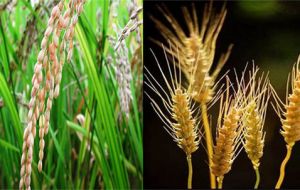MercoPress. South Atlantic News Agency
Food commodity markets more balances and less price volatile, says FAO
 Wheat and rice stocks are also projected to rise, by 7% and 3% respectively
Wheat and rice stocks are also projected to rise, by 7% and 3% respectively Food commodity markets are becoming more balanced and less price volatile than in recent years thanks to improved supplies and a recovery in global inventories of cereals, according to FAO's Food Outlook report published on Friday.
“The prices for most basic food commodities have declined over the past few months. This relates to production increases and the expectation that in the current season, we will have more abundant supplies, more export availabilities and higher stocks,” said David Hallam, Director of FAO's Trade and Markets Division.
The sharp increase in 2013 cereal production mostly stems from a recovery of maize crops in the United States and record wheat harvests in CIS countries. World rice production in 2013 is expected to grow only modestly.
Global stocks of cereals, ending in 2014, are also anticipated to increase, by 13%, to 564 million tons, with coarse grains alone up by 30%, mostly in the United States. Wheat and rice stocks are also projected to rise, by 7% and 3% respectively.
The expansion in world cereal stocks would result in the global cereal stocks-to-use ratio reaching 23%, well above the historical low of 18.4% in 2007/08.
In 2013, the world food import bill is set to decline by 3% to 1.15 trillion dollars, with import costs of cereals, sugar, vegetable oils and tropical beverages falling, but dairy, meat and fish remaining firm, according to FAO's latest Food Outlook.
The FAO Food Price Index, also published in this report, rose slightly in October, averaging 205.8 points. This was 2.7 points, or 1.3% above September, but still 11 points, or 5.3% below its October 2012 value. The slight increase was largely driven by a surge in sugar prices, although prices of the other commodity groups were also up.
The Index, which is a measure of the monthly change in international prices of five major food commodity groups (including 73 price quotations), has undergone some changes in the way it is calculated, although the new approach did not significantly alter the values in the series. The revised Index has also been extended back to 1961. The revisions are discussed in the Special Feature section of Food Outlook.
Forecasts for other commodities include:
Cassava - World cassava output is expected to increase for the fifth consecutive year and to reach 256 million tons in 2013. The expansion is being fueled by rising demand for food in the African continent and increasing industrial applications of cassava in East and Southeast Asia, especially for ethanol and starch.
Sugar - World sugar production is forecast to increase only slightly in 2013/14. The rise is likely to be limited in Brazil, the world's largest sugar producer and exporter, where unfavorable weather conditions have hampered harvesting operations. World sugar consumption is set to grow by about 2% in 2013/14.
Oilseeds - World oilcrop production could climb to an all-time high in 2013/14, supported by record soybean crops in South America. Global output of oilseed products should match world utilization for the second consecutive year, although a sizeable surplus is possible in the case of meals/cakes.
Meat - World meat production is anticipated to grow by 1.4% in 2013. Prices have remained at historically high levels since the beginning of 2011. There is no sign of overall price decreases, despite reduced feed costs.
Dairy - World milk production in 2013 is forecast to grow by 1.9%. Asia and Latin America and the Caribbean are expected to account for most of the increase, with only limited growth elsewhere. International dairy products prices have declined from their April peak, but still remain at historically high levels.
Fisheries - Aquaculture continues to boost overall fish supply, pushing quotations down from earlier levels. Fish consumption per capita keeps growing, with aquaculture in the process of overtaking capture fisheries as the main source of supply for direct human consumption. (FAO).-




Top Comments
Disclaimer & comment rulesCommenting for this story is now closed.
If you have a Facebook account, become a fan and comment on our Facebook Page!